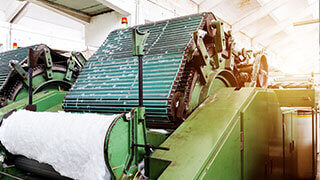Basics of Yarn Manufacturing
An Evolving High-Tech Industry
Over the last three-plus decades the yarn manufacturing segment of the textile industry has experienced a 10-fold increase in overall productivity. It has become a very high-tech part of the fabric-production process chain—providing the necessary raw materials for producing world-class fabrics for apparel, home furnishings, bed and bath, and industrial textile markets
The Cotton System
Cotton is the most widely used fiber for producing short staple spun yarns. Therefore, over the years the processing system for making these yarns has been called the cotton system. The cotton system processes fibers (natural and man-made) up to 2.5 inches in length. Other systems producing spun yarns are the woolen (fibers 2-3 inches long), worsted (fibers 3-5 inches long) and modified worsted (fibers 3-upto 8 inches long) systems.
Fiber Selection
In any spinning operation, the requirements of the end product, or of the consumer of the yarn, will be the dictating forces in determining the fiber quality and properties that are best suited for the most economic situation. Using fiber that is of better quality than required will prove unprofitable. Likewise, using fiber that is of poorer quality than required will result in losses as well. Correct decisions regarding the most suitable fiber properties for a given operation are paramount for maintaining profitability.
Process Flow Per Yarn Type
There are multiple processing steps in producing 100% cotton and cotton-blend short staple spun yarns. Each step is like the supplier for the next step which then becomes the “customer.” Each step is also a point of quality control which will be dependent upon utilizing best practices for producing world-class quality yarns.
Ring Spun
Opening
Carding
Breaker Drawing
Finisher Drawing
Roving
Ring Spinning
Winding
Ring Spun Combed
Opening
Carding
Prep Drawing
Lap Winding
Combing
Breaker Drawing
Finisher Drawing
Roving
Ring Spinning
Winding
Open End
Opening
Carding
Drawing
Open End Spinning
Air Jet
Opening
Carding
Breaker Drawing
Finisher Drawing
Air Jet Spinning
Fiber Preparation Processes
The opening through roving processes are many times referred to a fiber preparation processes. They are all together aimed at properly opening, cleaning, blending and aligning the fibers along with putting them in the proper form or substrate for spinning into a yarn.
These multiple processes are necessary to preserve fiber integrity by systematically and progressively operating on the fibers to accomplish prescribed objectives. Too aggressively working on the fibers during more abbreviated steps would break fibers and creative very weak and uneven yarns not suitable for high quality products.
Cotton Bale Management
Every bale of upland cotton in the United Stated is classed and graded using High Volume Instrument (HVI) testing. From this testing, done by USDA classing offices, important properties of the individual bale can be quantified and recorded. This same data is used not only to place a dollar value on the bale but can also be used by mills in order to ensure their success in producing a consistent end product. Cotton Incorporated has developed a software program called Engineered Fiber Selection (EFS) that uses this HVI generated data to manage and control the properties of the raw material flow in the spinning mill. This kind of controlled bale management not only maximizes the spinning mill’s efficient use of the cotton but can also improve the quality of the yarns being produced.
Cotton fiber samples are pulled from bales at the cotton gin and sent to classing offices to be tested on HVI testing lines as shown on the left above. The testing data for each bale will be recorded on a bale identification label and placed on the bale itself. This information will be available at each yarn manufacturing plant where the bales will be located in appropriate groups (as shown in middle picture above) by key properties such as fiber length, micronaire (fiber fineness), and fiber strength. Bales are then selected and placed into a bale laydown as shown on the right above. Fibers will next be fed into the opening line to begin the process of fiber preparation which will then be followed by yarn spinning.


